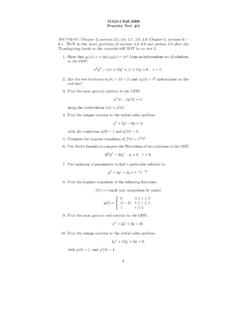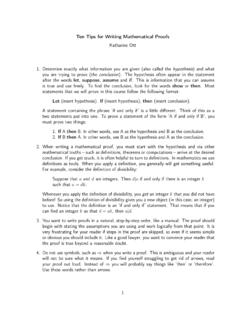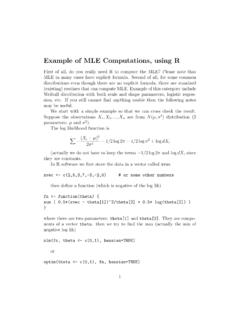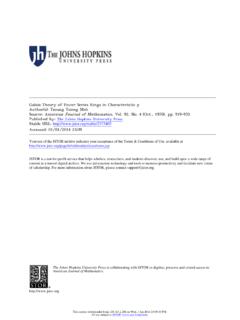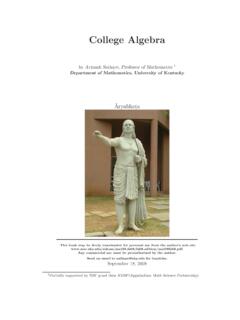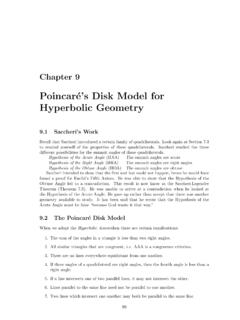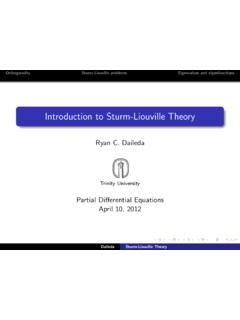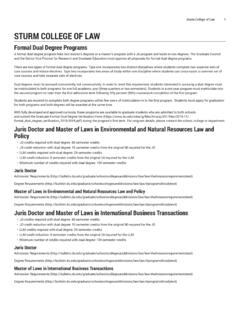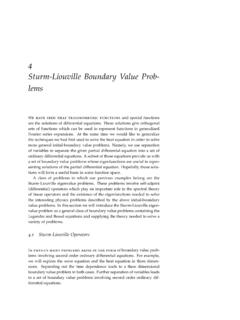Transcription of A (gentle) Introduction to Sturm-Liouville
1 IntroductionThe Non-Singular ProblemThe Singular ProblemReferencesA ( gentle ) Introduction to sturm -LiouvilleProblemsRyan WalkerMarch 10, 2010 Ryan WalkerA ( gentle ) Introduction to Sturm-Liouville ProblemsIntroductionThe Non-Singular ProblemThe Singular ProblemReferencesA Sturm-Liouville ProblemASturm- liouville problem(SLBVP) on [a,b] Ris a secondorder ODE with boundary conditions ataandb: u (x) +q(x)u(x) = u(x)x [a,b]u(a) cos( ) +u (a) sin( ) = 0u(b) cos( ) +u (b) sin( ) = 01We assume thatp(x),q(x) are general equation: every second order differential operatorcan be put into a Sturm-Liouville parameter suggests that our focus will be a kind ofeigenvalue problem. The theory of this type of eigenproblemis calledSturm- liouville form of the time-independent Schr odinger equation forenergy level .Ryan WalkerA ( gentle ) Introduction to Sturm-Liouville ProblemsIntroductionThe Non-Singular ProblemThe Singular ProblemReferencesSturm- liouville Theory1 Mathematicians have studied Sturm-Liouville problems forover 200 developed theory and remains an active area of results:a.
2 A complete spectral theory for problems where [a,b] is finiteand the potentialq(x) is A satisfying but complex theory for singular : Solutions to separable PDEs, major advances inspectral theory, various applications in WalkerA ( gentle ) Introduction to Sturm-Liouville ProblemsIntroductionThe Non-Singular ProblemThe Singular ProblemReferencesSpectral Theory for the Nonsingular ProblemNonsingular ExampleThe Nonsingular SL ProblemIntroduce the operator notationL(u) := u (x) +q(x)u(x).Thenonsingular SL problemis Lu= u(x)x [a,b]u(a) cos( ) +u (a) sin( ) = 0u(b) cos( ) +u (b) sin( ) = 0whereq(x) 0 and is continuously differentiable on [a,b].Ryan WalkerA ( gentle ) Introduction to Sturm-Liouville ProblemsIntroductionThe Non-Singular ProblemThe Singular ProblemReferencesSpectral Theory for the Nonsingular ProblemNonsingular ExampleAn Eigenvalue ProblemWe seek a complex number and a functionuwhich satisfies theboundary conditions andLu= pair ( ,u) is called aneigenpair, aneigenvalue, anduaneigenvector(or eigenfunction) of the regular WalkerA ( gentle ) Introduction to Sturm-Liouville ProblemsIntroductionThe Non-Singular ProblemThe Singular ProblemReferencesSpectral Theory for the Nonsingular ProblemNonsingular ExampleAn analogyThe main reason for considering the eigenvalue problem in matrixalgebra is the result:Theorem (Spectral Theorem for Square Matrices)Let A be an n n matrix on a finite dimensional, complex innerproduct space V.
3 If(Ax,y) = (x,Ay)where( , )is the innerproduct on V then1V has an orthonormal basis{v1,v2,..,vn}of eigenvectorscorresponding to distinct eigenvalues{ 1, 2,.., n}.2 The matrix A can be enacted asn i=1 iPiwhere iare distincteigenvalues of A and Piare orthogonal WalkerA ( gentle ) Introduction to Sturm-Liouville ProblemsIntroductionThe Non-Singular ProblemThe Singular ProblemReferencesSpectral Theory for the Nonsingular ProblemNonsingular ExampleThe PlanWith the spectral theorem for the matrixAin mind, we will seekto develop a spectral theory for the operatorLin our SLBVP. Asatisfying spectral theory should:1 Describe an expansion in eigenvectors for the Hilbert space a way to enact the transformationLas multiplicationand addition in an appropriate WalkerA ( gentle ) Introduction to Sturm-Liouville ProblemsIntroductionThe Non-Singular ProblemThe Singular ProblemReferencesSpectral Theory for the Nonsingular ProblemNonsingular ExampleThe Spectral Theorem for the Nonsingular sturm -LiouvilleProblemTheorem1 The operator L is self-adjoint on L2(a,b):(Lu,v) = (u,Lv).
4 2 The for which the non-singular SLBVP has a solution is adiscrete subset{ k} set{ k}of solutions corresponding to{ k}forms anorthogonal set in L2(a,b).4 Every f in L2(a,b)can be written as f= k=1ck kfor somechoice of coefficients WalkerA ( gentle ) Introduction to Sturm-Liouville ProblemsIntroductionThe Non-Singular ProblemThe Singular ProblemReferencesSpectral Theory for the Nonsingular ProblemNonsingular ExampleProof:Lis Self-Adjoint1In the finite dimensional case, (Ax,y) = (x,Ay) for allxissufficient to guarantee that all the eigenvalues ofAare turns out to also be the case for the :[fg](x) =f(x) g (x) f (x) g(x).Ryan WalkerA ( gentle ) Introduction to Sturm-Liouville ProblemsIntroductionThe Non-Singular ProblemThe Singular ProblemReferencesSpectral Theory for the Nonsingular ProblemNonsingular ExampleProof:Lis Self-AdjointFor self-adjointness(Lu,v) = ba( u (x) +q(x)u(x))v(x)dx= baq(x)v(x)u(x)dx bau (x)v(x)dx= baq(x)v(x)u(x)dx+ bau (x)v (x)dx+u (x)v(x) ba= baq(x)v(x)u(x) bau(x)v (x)dx+u(x)v(x) ba= bau(x) v (x) +q(x)v(x)dx= bau(x)Lv dx= (u,Lv)Ryan WalkerA ( gentle ) Introduction to Sturm-Liouville ProblemsIntroductionThe Non-Singular ProblemThe Singular ProblemReferencesSpectral Theory for the Nonsingular ProblemNonsingular ExampleProof.
5 All Real EigenvaluesA similar integration by parts argument shows that x2x1( g Lf fLf)dt= [fg](x2) [fg](x1)holding on every interval [x1,x2] and for anyf,gfor whichLf,Lgare be an eigenvalue ofLcorresponding to f Lf fLf= ( )|f|2( ) f 22= [ff](b) [ff](a) = 0 Nowf6= 0 inL2so that ( ) = 0 and hence=( ) =( )2i= WalkerA ( gentle ) Introduction to Sturm-Liouville ProblemsIntroductionThe Non-Singular ProblemThe Singular ProblemReferencesSpectral Theory for the Nonsingular ProblemNonsingular ExampleProof: Orthogonal EigenfunctionsNow suppose that therefandgare eigenfunctions correspondingto distinct eigenvalues and .Using x2x1( g Lf fLg)dt= [fg](x2) [fg](x1)we can write( ) baf g dx= ( )(f,g) = [fg](b) [fg](a) = any two eigenfunctions are WalkerA ( gentle ) Introduction to Sturm-Liouville ProblemsIntroductionThe Non-Singular ProblemThe Singular ProblemReferencesSpectral Theory for the Nonsingular ProblemNonsingular ExampleProof: Green s FunctionA Green s function for the operatorLis a function satisfying thefollowing :G(x,y) =G(y,x)2G(x,y) is continuous on [a,b] [a,b].
6 G(x,y) is twicecontinuously differentiable away from the setD={(x,x)|x [a,b]}.3 Atx=y, x Ghas a jump discontinuity. The jump satisfies x G(y+,y) x G(y ,y) = lim 0[ dx G(y+ ,y) x G(y , )]= 14On [a,b] [a,b]\D,G(x,y) satisfies the differential equationLxG(x, ) =Gxx(x,y) +q(x)G(x, )Ryan WalkerA ( gentle ) Introduction to Sturm-Liouville ProblemsIntroductionThe Non-Singular ProblemThe Singular ProblemReferencesSpectral Theory for the Nonsingular ProblemNonsingular ExampleProof: An Equivalent ProblemGiven such a Green s function forL, we can construct the integraloperator(Tf)(x) = baG(x,y)f(y)dyIntegrate by parts and use the boundary conditions to get:L(Tu)(x) =u(x) andT(Lu)(x) =u(x).ApplyTto the eigenvalue equationLu= theequivalent problem:Tu= uwhere = 1 and WLOG 6= WalkerA ( gentle ) Introduction to Sturm-Liouville ProblemsIntroductionThe Non-Singular ProblemThe Singular ProblemReferencesSpectral Theory for the Nonsingular ProblemNonsingular ExampleProof: A LemmaLemmaIf G(x,y)is a Green s function for the SLBVP, Rand a tothe SLBVP, the operatorT(u(x)) = ba[G(x,y) (x) (y)]u(y)dyhas either T or T as an WalkerA ( gentle ) Introduction to Sturm-Liouville ProblemsIntroductionThe Non-Singular ProblemThe Singular ProblemReferencesSpectral Theory for the Nonsingular ProblemNonsingular ExampleProof: Building an Orthonormal SetBy the lemma with = 0,Thas an eigenvector, so normalize itand call it 0.
7 Define a new operatorT1by(T1u)(x) = ba[G(x,y) 0 0(x) 0(y)]u(y) the conditions of the lemma so that it has either T1 or T1 as an eigenvalue, say 1. Normalize its eigenvectorand call it (T1u, 0) = 1( 1, 0)= (Tu, 0) 0(u, 0) ( 0, 0)= (u,T 0) 0(u, 0)= (u, 0) (u, 0)= 0and 1are an orthonormal set and| 1|= T 1 T =| 0|.Ryan WalkerA ( gentle ) Introduction to Sturm-Liouville ProblemsIntroductionThe Non-Singular ProblemThe Singular ProblemReferencesSpectral Theory for the Nonsingular ProblemNonsingular ExampleBuilding an Orthonormal SetWe continue in this way, writing next(T2u)(x) = ba[G(x,y) 0 0(x) 0(y) 1 1(x) 1(y)] a similar argument with inner products and operator norms toobtain a vector 2orthogonal to 1and 0, with an eigenvalue 2satisfying| 0| | 1| | 2|.We can continue this process provided that no n= thiswon t happen for anyn Nsince otherwise0 =L(Tnu) =L(Tu) n 1 k=0 k(u, k)L k=u n 1 k=0 k(u, k)L kwhich means thatu=n 1 k=0 k(u, k)L k=n 1 k=0(u, k)LT k=n 1 k=0(u, k) kholds for allu C2[a,b].
8 Ryan WalkerA ( gentle ) Introduction to Sturm-Liouville ProblemsIntroductionThe Non-Singular ProblemThe Singular ProblemReferencesSpectral Theory for the Nonsingular ProblemNonsingular ExampleProof: Completeness (Sketch)Now that we have an infinite sequence of solutions k, we want toestablish that this sequence is complete. That is, we want to showthat the sequence spans the set ofL2[a,b] functions. Here is anoutline of that proof:1 Use the structure ofTnand Bessel s inequality to show that Tu k=0 k(u, k) k 0 uniformly foru C[a,b].2 Setu=Lfforf C2[a,b] satisfying the boundaryconditions. Notice that k(u, k) = (u, k k) = (u,T k) = (Tu, k) = (f, k)3 Use the equalityTu(x) = k=0 k(u, k) kto prove thatf(x) = k=0(f, k) k4 Use standard approximation arguments to prove that theformula holds for anyf L2[a,b] (regardless of the boundaryconditions).Ryan WalkerA ( gentle ) Introduction to Sturm-Liouville ProblemsIntroductionThe Non-Singular ProblemThe Singular ProblemReferencesSpectral Theory for the Nonsingular ProblemNonsingular ExampleExample 1 Letb>0,f(x) L2(0,b) and consider the heat problem ut uxx= 0 on [0,b] [0, )u(0,t) =u(L,t) = 0 fort [0, )u(x,0) =f(x) forx [0,b].]]
9 This problem models the distribution of heat in rod of lengthbwith initial temperaturef(x) and insulated WalkerA ( gentle ) Introduction to Sturm-Liouville ProblemsIntroductionThe Non-Singular ProblemThe Singular ProblemReferencesSpectral Theory for the Nonsingular ProblemNonsingular ExampleExample 1 Guess that there is a solution to the problem of the formu(x,t) =v(t)w(x).Substitute:v (t)v(t)=w (x)w(x).Such a relation can hold only when both of these terms areconstants, that is =v (t)v(t)=w (x)w(x).This leads to the pair of ordinary differential equationsw = wand v= WalkerA ( gentle ) Introduction to Sturm-Liouville ProblemsIntroductionThe Non-Singular ProblemThe Singular ProblemReferencesSpectral Theory for the Nonsingular ProblemNonsingular ExampleExample 1 With the boundary conditionw(0) =w(b) = 0 and Calculus IVmethods all solutions of thewproblem are of the formw(x) =Acos( x) +Bsin( x)and all solutions of thevproblem are of the form:v(t) =Ce tRyan WalkerA ( gentle ) Introduction to Sturm-Liouville ProblemsIntroductionThe Non-Singular ProblemThe Singular ProblemReferencesSpectral Theory for the Nonsingular ProblemNonsingular ExampleExample 1 From the left-hand boundary conditionw(0) = 0 we see thatw(x) =Bsin( x)Now from the right-hand boundary conditionw(b) = 0 n=n2 2b2forn we have determined all the eigenvalues forLwith theseboundary conditions.
10 Moreover it is easy to see that to each nthere corresponds an eigenfunctionwn(x) = 2bsin(n bx).Ryan WalkerA ( gentle ) Introduction to Sturm-Liouville ProblemsIntroductionThe Non-Singular ProblemThe Singular ProblemReferencesSpectral Theory for the Nonsingular ProblemNonsingular ExampleExample 1 For eachn Nun(x,t) =Dne t( 2bsin(n bx))satisfies the heat equation with the conditionun(0,t) =un(L,t) = to construct:u(x,0) =f(x).Ryan WalkerA ( gentle ) Introduction to Sturm-Liouville ProblemsIntroductionThe Non-Singular ProblemThe Singular ProblemReferencesSpectral Theory for the Nonsingular ProblemNonsingular ExampleAn ExampleWrite:un(x,0) =Dnwn(x).Thewproblem is a regular Sturm-Liouville problem. So{wn}is a complete orthonormal there must be a choice ofDnso thatf(x) = n= fact, the correct choice ofDnis given byDn=2b b0f(x)wn(x) :u(x,t) = n=1 Dne ntwn(x).Ryan WalkerA ( gentle ) Introduction to Sturm-Liouville ProblemsIntroductionThe Non-Singular ProblemThe Singular ProblemReferencesOverviewThe Half-Line SL ProblemSingular Problem ExampleCommentsSingularity in Sturm-Liouville ProblemsThere are two notions of singularity in Sturm-Liouville first kind of singularity occurs when the potentialq(x) hassingularity.
